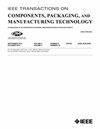PCB Layout-Based Spatiotemporal Graph Convolution Network for Anomaly Prediction in Solder Paste Printing
IF 2.3
3区 工程技术
Q2 ENGINEERING, ELECTRICAL & ELECTRONIC
IEEE Transactions on Components, Packaging and Manufacturing Technology
Pub Date : 2024-11-18
DOI:10.1109/TCPMT.2024.3502137
引用次数: 0
Abstract
Predicting solder paste printing anomaly on the printed circuit board (PCB) can improve first-pass yield and reduce rework costs. Considering the impact of the PCB layout on the quality of solder paste printing, we propose a PCB layout-based spatiotemporal graph convolution network, in which we construct a graph to model the spatial distribution of solder pads. Specifically, since the printing quality is related to the spatial distribution of the pads, we convert the PCB to a graph according to the Pearson correlation of the printing quality and then trim the edges of the graph with a correlation threshold to model the spatial distribution of solder pads. To model the time-varying physicochemical properties of the solder paste, normalize the production time, calculate the attention of the production time, and reconstruct the printing quality based on the attention. Then, we devise a weighted loss to improve the performance of predicted printing of defective products due to the scarcity of defective products. Ultimately, the predicted printing quality is compared with the inspection threshold to estimate the degree of anomaly. The proposed method is validated on six days of real solder paste printing data, improving the average基于PCB布置图的锡膏印刷异常预测时空图卷积网络
预测印刷电路板(PCB)上的锡膏印刷异常可以提高一次通过率,降低返工成本。考虑到PCB布局对锡膏印刷质量的影响,我们提出了一种基于PCB布局的时空图卷积网络,在该网络中我们构建了一个图来模拟锡垫的空间分布。具体来说,由于印刷质量与焊盘的空间分布有关,我们根据印刷质量的Pearson相关性将PCB转换为图形,然后用相关阈值修剪图形的边缘,以模拟焊盘的空间分布。对锡膏的时变物理化学性质进行建模,对生产时间进行归一化,计算生产时间的注意力,并根据注意力重构印刷质量。然后,我们设计了一个加权损失,以提高由于不良品稀缺而导致的不良品预测印刷的性能。最后,将预测的打印质量与检测阈值进行比较,以估计异常程度。该方法在6天的实际锡膏印刷数据上进行了验证,在两个时间预测尺度上,三种典型异常印刷行为的平均$F1$分数提高了0.057分,平均精度提高了0.022分。
本文章由计算机程序翻译,如有差异,请以英文原文为准。
求助全文
约1分钟内获得全文
求助全文
来源期刊

IEEE Transactions on Components, Packaging and Manufacturing Technology
ENGINEERING, MANUFACTURING-ENGINEERING, ELECTRICAL & ELECTRONIC
CiteScore
4.70
自引率
13.60%
发文量
203
审稿时长
3 months
期刊介绍:
IEEE Transactions on Components, Packaging, and Manufacturing Technology publishes research and application articles on modeling, design, building blocks, technical infrastructure, and analysis underpinning electronic, photonic and MEMS packaging, in addition to new developments in passive components, electrical contacts and connectors, thermal management, and device reliability; as well as the manufacture of electronics parts and assemblies, with broad coverage of design, factory modeling, assembly methods, quality, product robustness, and design-for-environment.
 求助内容:
求助内容: 应助结果提醒方式:
应助结果提醒方式:


